KIA Optima Hybrid 2014 3.G Owner's Manual
Manufacturer: KIA, Model Year: 2014, Model line: Optima Hybrid, Model: KIA Optima Hybrid 2014 3.GPages: 474, PDF Size: 12.73 MB
Page 331 of 474
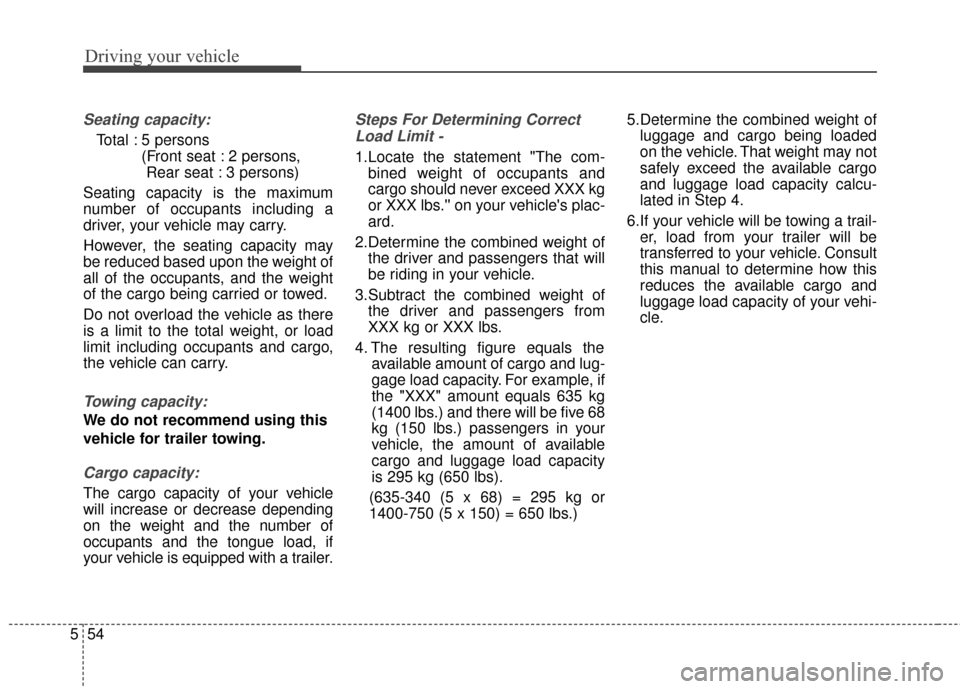
Driving your vehicle
54
5
Seating capacity:
Total : 5 persons
(Front seat : 2 persons, Rear seat : 3 persons)
Seating capacity is the maximum
number of occupants including a
driver, your vehicle may carry.
However, the seating capacity may
be reduced based upon the weight of
all of the occupants, and the weight
of the cargo being carried or towed.
Do not overload the vehicle as there
is a limit to the total weight, or load
limit including occupants and cargo,
the vehicle can carry.
Towing capacity:
We do not recommend using this
vehicle for trailer towing.
Cargo capacity:
The cargo capacity of your vehicle
will increase or decrease depending
on the weight and the number of
occupants and the tongue load, if
your vehicle is equipped with a trailer.
Steps For Determining Correct Load Limit -
1.Locate the statement "The com- bined weight of occupants and
cargo should never exceed XXX kg
or XXX lbs.'' on your vehicle's plac-
ard.
2.Determine the combined weight of the driver and passengers that will
be riding in your vehicle.
3.Subtract the combined weight of the driver and passengers from
XXX kg or XXX lbs.
4. The resulting figure equals the available amount of cargo and lug-
gage load capacity. For example, if
the "XXX" amount equals 635 kg
(1400 lbs.) and there will be five 68
kg (150 lbs.) passengers in your
vehicle, the amount of available
cargo and luggage load capacity
is 295 kg (650 lbs).
(635-340 (5 x 68) = 295 kg or
1400-750 (5 x 150) = 650 lbs.) 5.Determine the combined weight of
luggage and cargo being loaded
on the vehicle. That weight may not
safely exceed the available cargo
and luggage load capacity calcu-
lated in Step 4.
6.If your vehicle will be towing a trail- er, load from your trailer will be
transferred to your vehicle. Consult
this manual to determine how this
reduces the available cargo and
luggage load capacity of your vehi-
cle.
Page 332 of 474
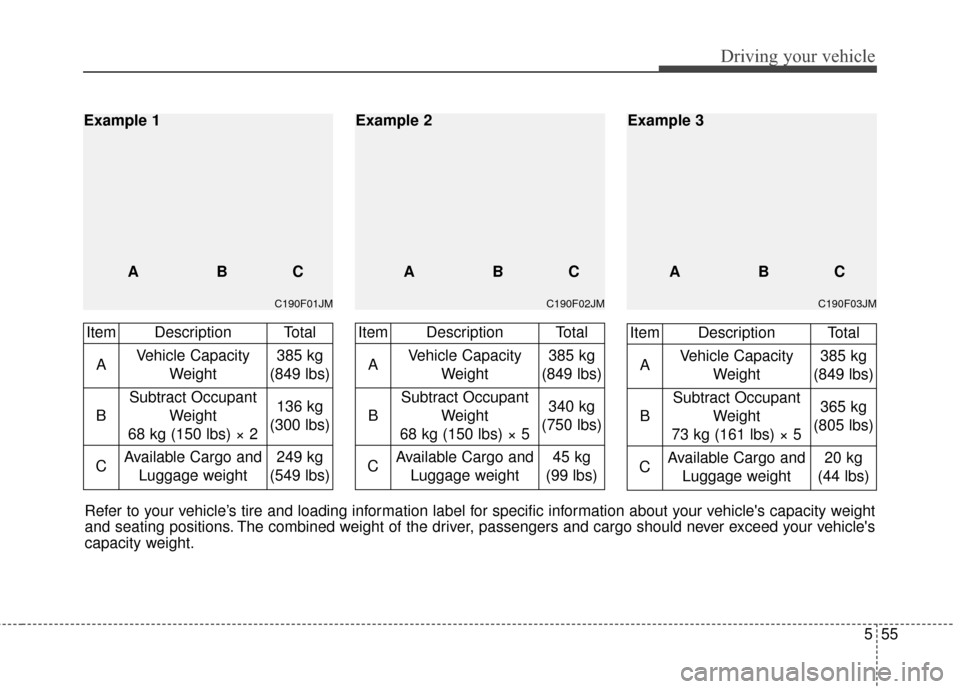
555
Driving your vehicle
C190F03JM
ABC
Example 3
C190F02JM
ABC
Example 2
C190F01JM
Example 1
ABC
Refer to your vehicle’s tire and loading information label for specific information about your vehicle's capacity weight
and seating positions. The combined weight of the driver, passengers and cargo should never exceed your vehicle's
capacity weight. Item Description Total
A Vehicle Capacity
Weight 385 kg
(849 lbs)
B Subtract Occupant
Weight
68 kg (150 lbs) × 2 136 kg
(300 lbs)
C Available Cargo and
Luggage weight 249 kg
(549 lbs)
Item Description Total
A Vehicle Capacity
Weight 385 kg
(849 lbs)
B Subtract Occupant
Weight
73 kg (161 lbs) × 5 365 kg
(805 lbs)
C Available Cargo and
Luggage weight 20 kg
(44 lbs)Item Description Total
A Vehicle Capacity
Weight 385 kg
(849 lbs)
B Subtract Occupant
Weight
68 kg (150 lbs) × 5 340 kg
(750 lbs)
C Available Cargo and
Luggage weight 45 kg
(99 lbs)
Page 333 of 474
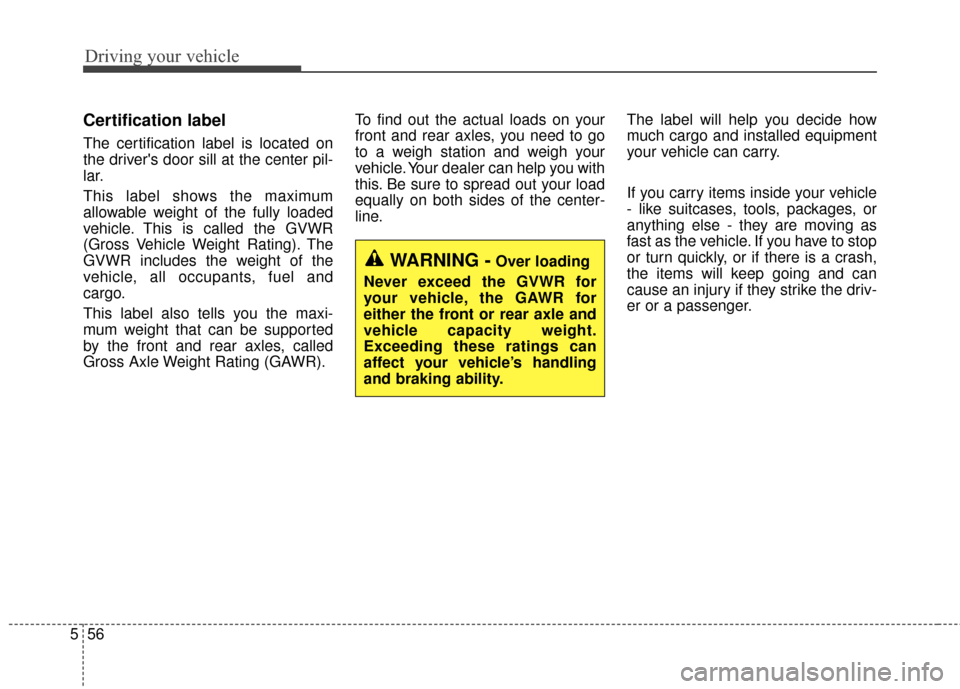
Driving your vehicle
56
5
Certification label
The certification label is located on
the driver's door sill at the center pil-
lar.
This label shows the maximum
allowable weight of the fully loaded
vehicle. This is called the GVWR
(Gross Vehicle Weight Rating). The
GVWR includes the weight of the
vehicle, all occupants, fuel and
cargo.
This label also tells you the maxi-
mum weight that can be supported
by the front and rear axles, called
Gross Axle Weight Rating (GAWR). To find out the actual loads on your
front and rear axles, you need to go
to a weigh station and weigh your
vehicle. Your dealer can help you with
this. Be sure to spread out your load
equally on both sides of the center-
line.
The label will help you decide how
much cargo and installed equipment
your vehicle can carry.
If you carry items inside your vehicle
- like suitcases, tools, packages, or
anything else - they are moving as
fast as the vehicle. If you have to stop
or turn quickly, or if there is a crash,
the items will keep going and can
cause an injury if they strike the driv-
er or a passenger.
WARNING -Over loading
Never exceed the GVWR for
your vehicle, the GAWR for
either the front or rear axle and
vehicle capacity weight.
Exceeding these ratings can
affect your vehicle’s handling
and braking ability.
Page 334 of 474
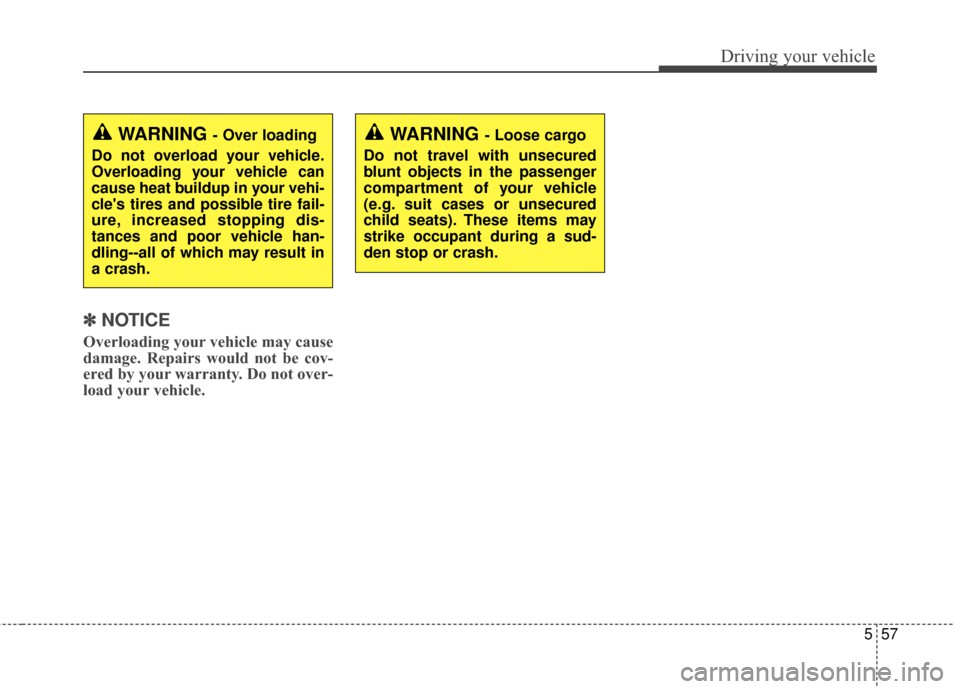
557
Driving your vehicle
✽
✽NOTICE
Overloading your vehicle may cause
damage. Repairs would not be cov-
ered by your warranty. Do not over-
load your vehicle.
WARNING - Over loading
Do not overload your vehicle.
Overloading your vehicle can
cause heat buildup in your vehi-
cle's tires and possible tire fail-
ure, increased stopping dis-
tances and poor vehicle han-
dling--all of which may result in
a crash.WARNING - Loose cargo
Do not travel with unsecured
blunt objects in the passenger
compartment of your vehicle
(e.g. suit cases or unsecured
child seats). These items may
strike occupant during a sud-
den stop or crash.
Page 335 of 474
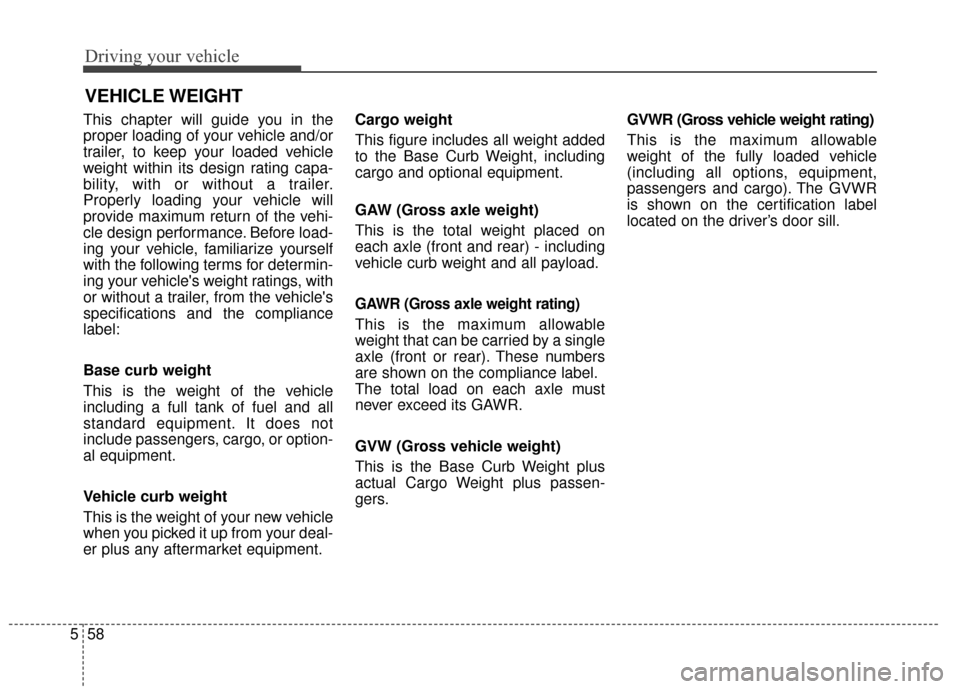
Driving your vehicle
58
5
This chapter will guide you in the
proper loading of your vehicle and/or
trailer, to keep your loaded vehicle
weight within its design rating capa-
bility, with or without a trailer.
Properly loading your vehicle will
provide maximum return of the vehi-
cle design performance. Before load-
ing your vehicle, familiarize yourself
with the following terms for determin-
ing your vehicle's weight ratings, with
or without a trailer, from the vehicle's
specifications and the compliance
label:
Base curb weight
This is the weight of the vehicle
including a full tank of fuel and all
standard equipment. It does not
include passengers, cargo, or option-
al equipment.
Vehicle curb weight
This is the weight of your new vehicle
when you picked it up from your deal-
er plus any aftermarket equipment. Cargo weight
This figure includes all weight added
to the Base Curb Weight, including
cargo and optional equipment.
GAW (Gross axle weight)
This is the total weight placed on
each axle (front and rear) - including
vehicle curb weight and all payload.
GAWR (Gross axle weight rating)
This is the maximum allowable
weight that can be carried by a single
axle (front or rear). These numbers
are shown on the compliance label.
The total load on each axle must
never exceed its GAWR.
GVW (Gross vehicle weight)
This is the Base Curb Weight plus
actual Cargo Weight plus passen-
gers.
GVWR (Gross vehicle weight rating)
This is the maximum allowable
weight of the fully loaded vehicle
(including all options, equipment,
passengers and cargo). The GVWR
is shown on the certification label
located on the driver’s door sill.
VEHICLE WEIGHT
Page 336 of 474
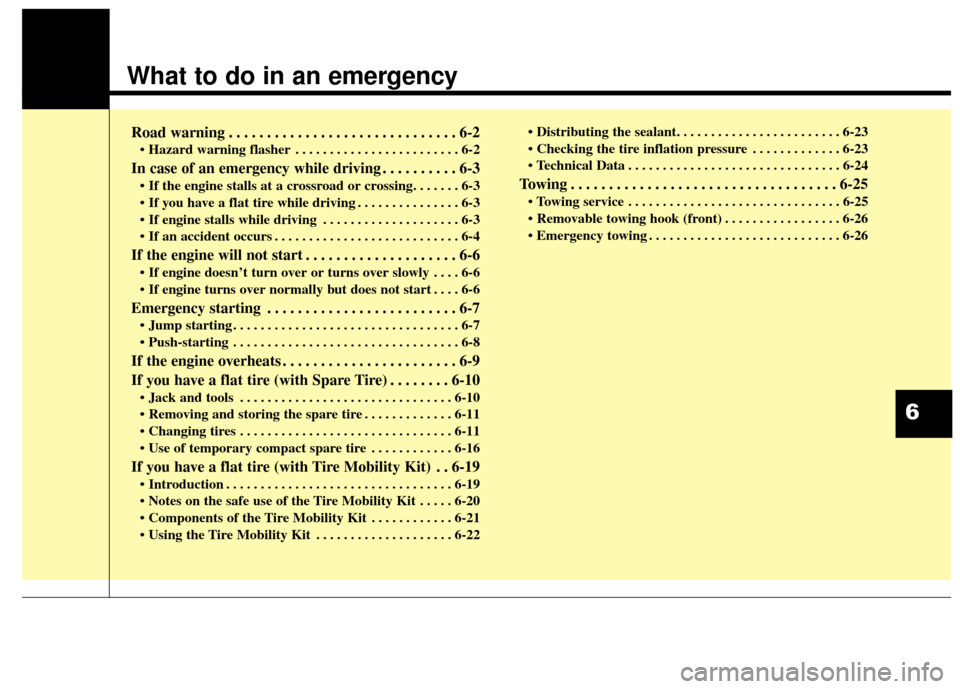
What to do in an emergency
Road warning . . . . . . . . . . . . . . . . . . . . . . . . . . . . . . 6-2
• Hazard warning flasher . . . . . . . . . . . . . . . . . . . . . . . . 6-2
In case of an emergency while driving . . . . . . . . . . 6-3
. . . . . . . . . . . . . . . 6-3
. . . . . . . . . . . . . . . . . . . . 6-3
. . . . . . . . . . . . . . . . . . . . . . . . . . . 6-4
If the engine will not start . . . . . . . . . . . . . . . . . . . . 6-6
. . . . 6-6
. . . . 6-6
Emergency starting . . . . . . . . . . . . . . . . . . . . . . . . . 6-7
. . . . . . . . . . . . . . . . . . . . . . . . . . . . . . . . . 6-7
. . . . . . . . . . . . . . . . . . . . . . . . . . . . . . . . . 6-8
If the engine overheats . . . . . . . . . . . . . . . . . . . . . . . 6-9
If you have a flat tire (with Spare Tire) . . . . . . . . 6-10
. . . . . . . . . . . . . . . . . . . . . . . . . . . . . . . 6-10
. . . . . . . . . . . . . 6-11
. . . . . . . . . . . . . . . . . . . . . . . . . . . . . . . 6-11
. . . . . . . . . . . . 6-16
If you have a flat tire (with Tire Mobility Kit) . . 6-19
. . . . . . . . . . . . . . . . . . . . . . . . . . . . . . . . . 6-19
. . . . . 6-20
. . . . . . . . . . . . 6-21
. . . . . . . . . . . . . . . . . . . . 6-22
. . . . . . . . . . . . . 6-23
. . . . . . . . . . . . . . . . . . . . . . . . . . . . . . . 6-24
Towing . . . . . . . . . . . . . . . . . . . . . . . . . . . . . . . . . . . 6-\
25
. . . . . . . . . . . . . . . . . . . . . . . . . . . . . . . 6-25
. . . . . . . . . . . . . . . . . 6-26
. . . . . . . . . . . . . . . . . . . . . . . . . . . . 6-26
6
Page 337 of 474
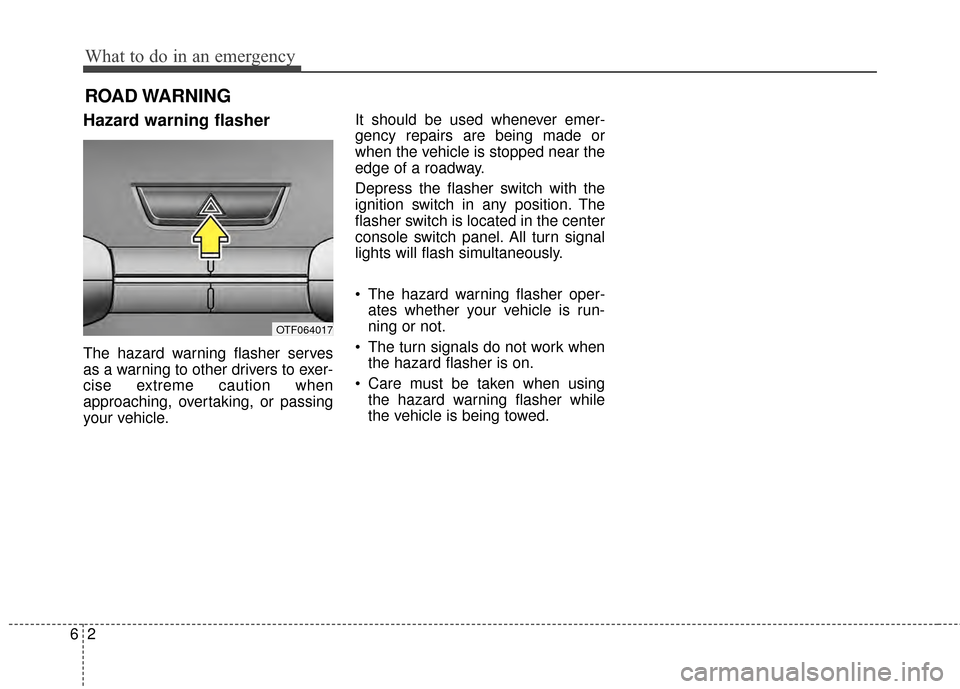
What to do in an emergency
26
ROAD WARNING
Hazard warning flasher
The hazard warning flasher serves
as a warning to other drivers to exer-
cise extreme caution when
approaching, overtaking, or passing
your vehicle.It should be used whenever emer-
gency repairs are being made or
when the vehicle is stopped near the
edge of a roadway.
Depress the flasher switch with the
ignition switch in any position. The
flasher switch is located in the center
console switch panel. All turn signal
lights will flash simultaneously.
• The hazard warning flasher oper-
ates whether your vehicle is run-
ning or not.
The turn signals do not work when the hazard flasher is on.
Care must be taken when using the hazard warning flasher while
the vehicle is being towed.
OTF064017
Page 338 of 474
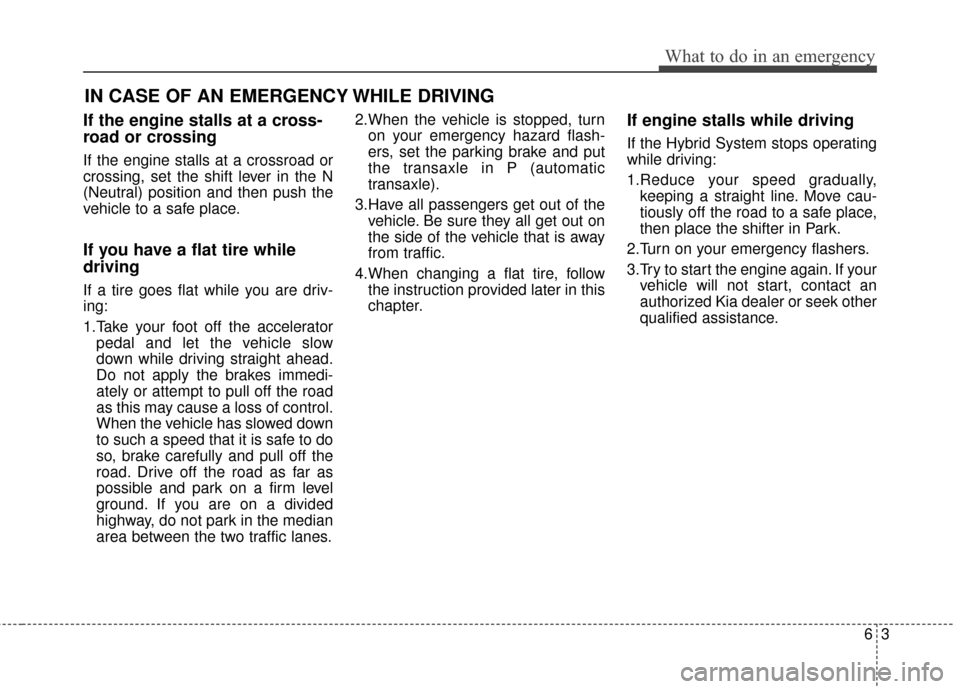
63
What to do in an emergency
If the engine stalls at a cross-
road or crossing
If the engine stalls at a crossroad or
crossing, set the shift lever in the N
(Neutral) position and then push the
vehicle to a safe place.
If you have a flat tire while
driving
If a tire goes flat while you are driv-
ing:
1.Take your foot off the acceleratorpedal and let the vehicle slow
down while driving straight ahead.
Do not apply the brakes immedi-
ately or attempt to pull off the road
as this may cause a loss of control.
When the vehicle has slowed down
to such a speed that it is safe to do
so, brake carefully and pull off the
road. Drive off the road as far as
possible and park on a firm level
ground. If you are on a divided
highway, do not park in the median
area between the two traffic lanes. 2.When the vehicle is stopped, turn
on your emergency hazard flash-
ers, set the parking brake and put
the transaxle in P (automatic
transaxle).
3.Have all passengers get out of the vehicle. Be sure they all get out on
the side of the vehicle that is away
from traffic.
4.When changing a flat tire, follow the instruction provided later in this
chapter.
If engine stalls while driving
If the Hybrid System stops operating
while driving:
1.Reduce your speed gradually,keeping a straight line. Move cau-
tiously off the road to a safe place,
then place the shifter in Park.
2.Turn on your emergency flashers.
3.Try to start the engine again. If your vehicle will not start, contact an
authorized Kia dealer or seek other
qualified assistance.
IN CASE OF AN EMERGENCY WHILE DRIVING
Page 339 of 474
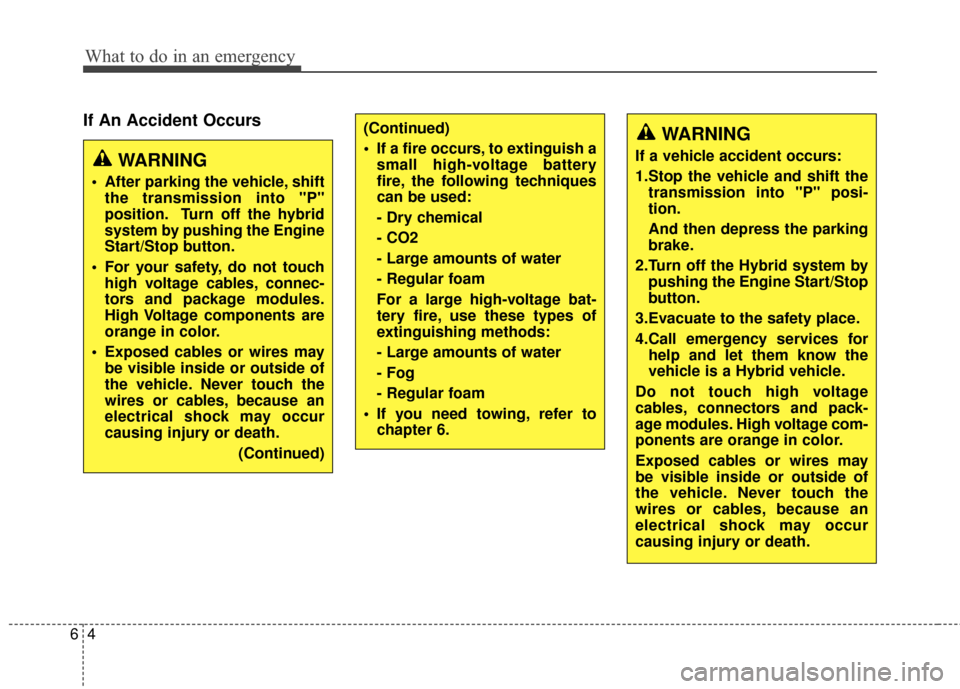
What to do in an emergency
46
If An Accident Occurs
WARNING
• After parking the vehicle, shiftthe transmission into "P"
position. Turn off the hybrid
system by pushing the Engine
Start/Stop button.
For your safety, do not touch high voltage cables, connec-
tors and package modules.
High Voltage components are
orange in color.
Exposed cables or wires may be visible inside or outside of
the vehicle. Never touch the
wires or cables, because an
electrical shock may occur
causing injury or death.
(Continued)
(Continued)
If a fire occurs, to extinguish asmall high-voltage battery
fire, the following techniques
can be used:
- Dry chemical
- CO2
- Large amounts of water
- Regular foam
For a large high-voltage bat-
tery fire, use these types of
extinguishing methods:
- Large amounts of water
- Fog
- Regular foam
If you need towing, refer to chapter 6.WARNING
If a vehicle accident occurs:
1.Stop the vehicle and shift thetransmission into "P" posi-
tion.
And then depress the parking
brake.
2.Turn off the Hybrid system by pushing the Engine Start/Stop
button.
3.Evacuate to the safety place.
4.Call emergency services for help and let them know the
vehicle is a Hybrid vehicle.
Do not touch high voltage
cables, connectors and pack-
age modules. High voltage com-
ponents are orange in color.
Exposed cables or wires may
be visible inside or outside of
the vehicle. Never touch the
wires or cables, because an
electrical shock may occur
causing injury or death.
Page 340 of 474
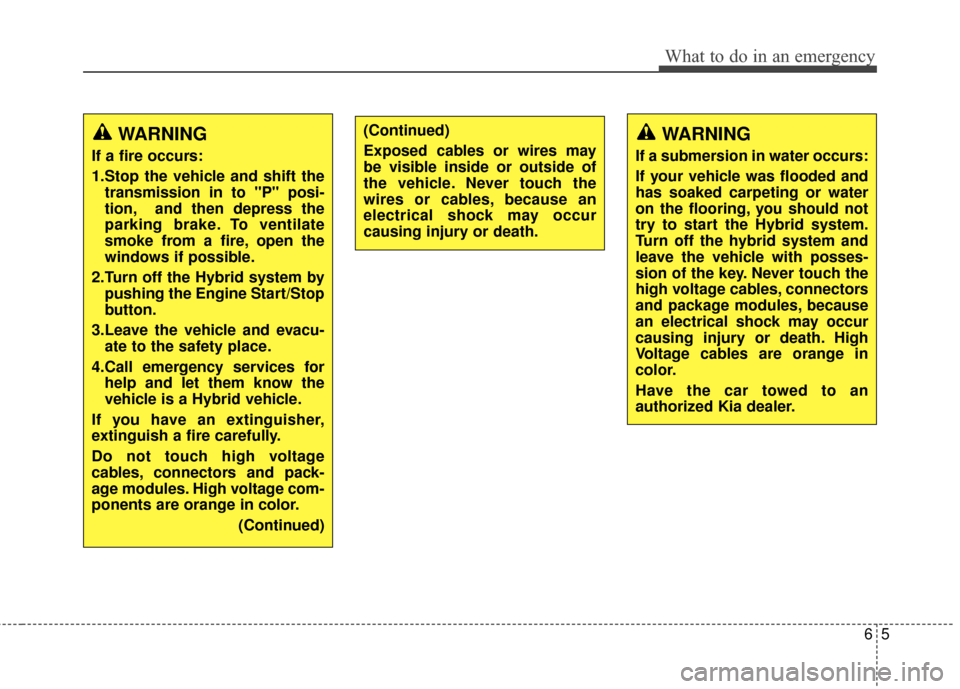
65
What to do in an emergency
WARNING
If a fire occurs:
1.Stop the vehicle and shift thetransmission in to "P" posi-
tion, and then depress the
parking brake. To ventilate
smoke from a fire, open the
windows if possible.
2.Turn off the Hybrid system by pushing the Engine Start/Stop
button.
3.Leave the vehicle and evacu- ate to the safety place.
4.Call emergency services for help and let them know the
vehicle is a Hybrid vehicle.
If you have an extinguisher,
extinguish a fire carefully.
Do not touch high voltage
cables, connectors and pack-
age modules. High voltage com-
ponents are orange in color. (Continued)
(Continued)
Exposed cables or wires may
be visible inside or outside of
the vehicle. Never touch the
wires or cables, because an
electrical shock may occur
causing injury or death.WARNING
If a submersion in water occurs:
If your vehicle was flooded and
has soaked carpeting or water
on the flooring, you should not
try to start the Hybrid system.
Turn off the hybrid system and
leave the vehicle with posses-
sion of the key. Never touch the
high voltage cables, connectors
and package modules, because
an electrical shock may occur
causing injury or death. High
Voltage cables are orange in
color.
Have the car towed to an
authorized Kia dealer.